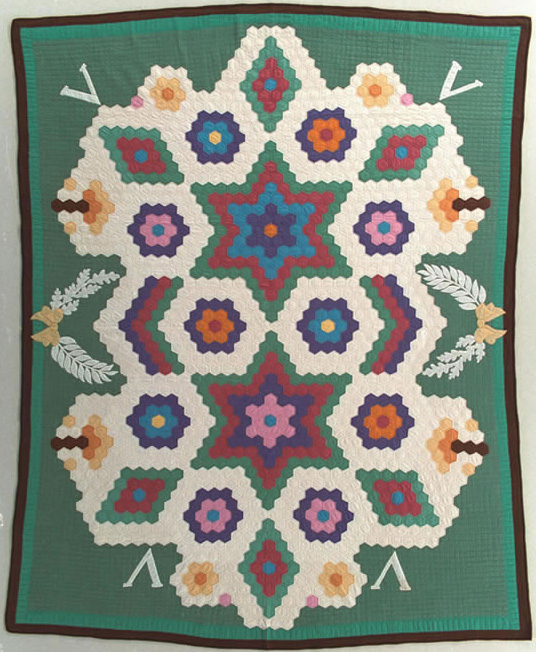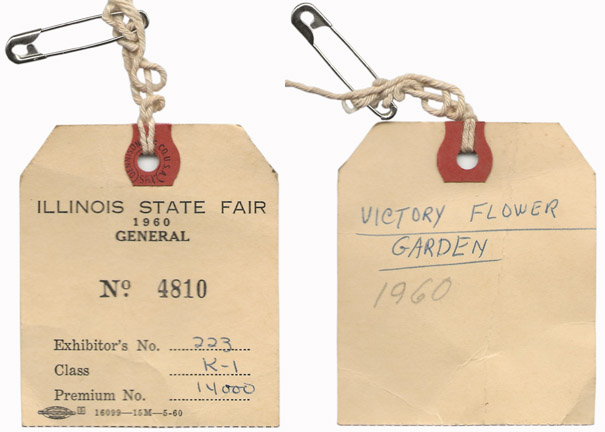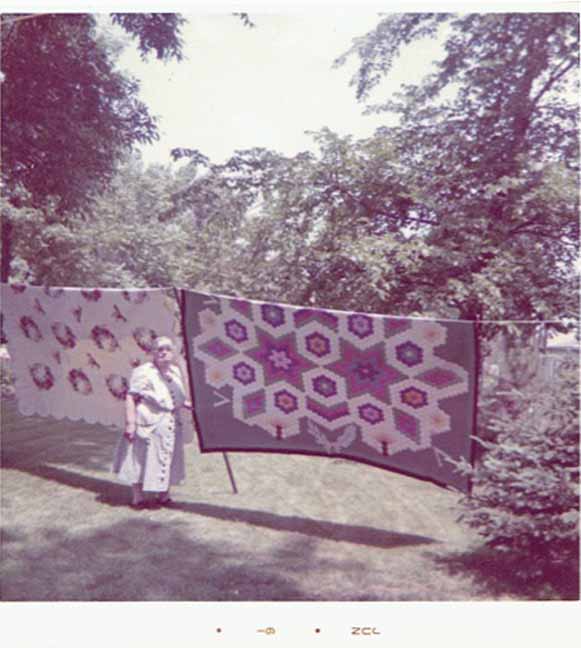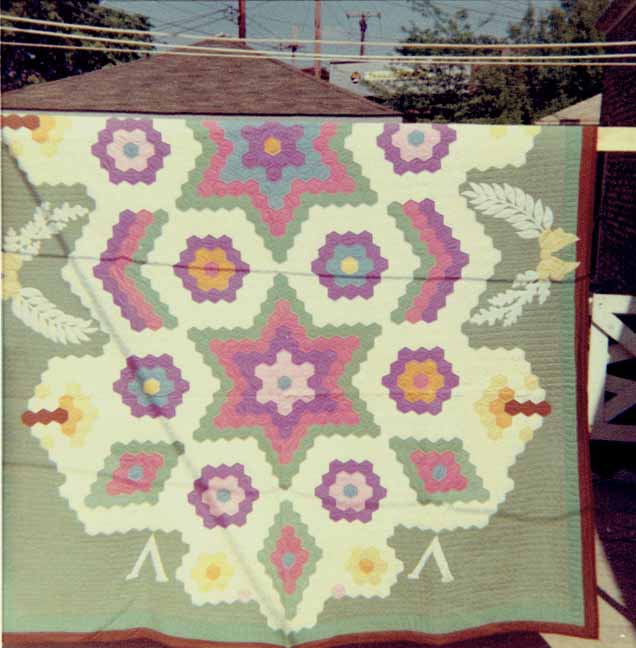
QUILT INDEX RECORD
18-14-44
Essay:
This might be a 1930s top that was finished in the 1940s during WWII. Gasperik probably picked up a Detroit News pattern called Diamond-Hexagon Quilt ID32 at the very first Detroit News Quilt Show she attended, in October 1935. Perhaps it gave her ideas for arranging the hexagons in a diamond shape, as well as providing her basic pattern unit. Notice the "V" for Victory appliquéd in the four corners. The two appliqué wreaths which combine oak and olive branches are symbols which can be found on historic flags of Hungary, Gasperik's home country.
This quilt is Mary's personal expression of her hope for future peace in the world and for the survival of her native Hungary. To a traditional pattern, she added symbols to honor her two countries: V for Victory of the Allied Cause and the Oak and Olive Branch Wreath, a symbol found surrounding the coat of arms on historical flags of Hungary.
Where are the records for this quilt housed?
Mary Gasperik Legacy Project
Who documented this quilt?
Mary Gasperik Private Collection
Gasperik Legacy Project Number:
023
This is a:
Finished quilt
Quilt's title:
Victory Garden
Owner's name for quilt:
Victory Garden
Names for quilt's pattern in common use:
Grandmother's Victory Garden
How wide is the quilt?
84 inches
How long is the quilt?
98 inches
Shape of edge:
Straight
Shape of corners:
Straight
What color is the quilt?
Blue or Navy; Gold; Green; Pink; Purple; Turquoise or Teal; White
Overall color scheme:
Bright or primary colors
Quilt's condition:
Excellent/like new
Time period:
1930-1949
When was the quilt finished?
1940s
Date estimated by an antique dealer, quilt historian or appraiser:
Mid 1940s
Who estimated the quilt's date?
Merikay Waldvogel
Further information concerning dates:
This might be a 1930s top that was finished in the 1940s during WWII. Note the V for Victory.
Describe the quilt's layout:
One patch or allover
Describe the quilt setting:
Traditional Grandmother's Flower Garden is reworked as diamonds, stars, and chevrons.
What is the shape of the quilt blocks?
Hexagons
Number of borders:
2
Describe the borders:
Two narrow bands in brown and green on all four sides.
Fiber types used to make the quilt top:
Cotton
Fabric styles used in the quilt top:
Solid/plain
Piecing techniques used to make the quilt top:
Hand Piecing
Applique techniques used to make the quilt top:
Hand Applique
Describe embellishment materials or techniques:
Applique wreaths combining laurel (or olive) branch on one side and oak branch on the other.
Materials used to make the back:
Cotton
Materials used in the quilt binding:
Cotton
What kind of filling is used in the quilt?
Cotton
How are the layers held together?
Hand quilting
Quilting designs used, overall motifs:
Outline
Quilting designs used, background fills:
Grid/crosshatch
Features or notes about the quilt's appearance, materials, or construction:
Susan Salser believes that the addition of the V's at the four corners and the wreaths combining laurel and oak branches is Gasperik's Hungarian statement on World War II. A similar combination wreath was a Hungarian national symbol when it was independent.
Quilt top made by:
Gasperik, Mary
Quilted by:
Gasperik, Mary
Where the quilt was made, city:
Chicago
Where the quilt was made, county:
Cook County
Where the quilt was made, state:
Illinois (IL)
Where the quilt was made, country:
United States
How was this quilt acquired?
Inheritance
Tell the story of how the quilt was obtained:
Shortly before she died, Mary Gasperik asked her daughter Elsie to select 3 quilts as gifts for her granddaughters Joanne, Charlene and Louise Gasperik. This is one of the three quilts Elsie selected and gave to the girls' mother, Erika Gasperik. It was chosen by Charlene.
Why was the quilt made?
Art or personal expression
The quilt was made to be used for:
Unknown
Quilt is presently used as:
Keepsake/memento
Describe present uses of the quilt:
Mary's grandchildren regard her quilts as a unique collection to be preserved and appreciated.
Where did the maker get their materials?
Purchased new
Where did the maker find their pattern?
Traditional pattern variation
Where did the quiltmaker find the pattern for the quilting design on the quilt?
Original to maker
Describe anything about the design of the quilt that wasn't already recorded in a previous field:
It may be that Gasperik pieced this quilt some years before she completed it as a wartime quilt. The flower garden pattern was very popular with The Detroit News Quilt Club and its quilt shows, as Gasperik no doubt learned when she encountered them in 1935, her first visit to that huge quilt show. In her quilt column of December 31, 1935 (p 18) Detroit Quilt Club Director Edith Crumb described the popularity of the Flower Garden quilt as follows: "A hundred years from now if quilts we have made are brought together - think what the result would be! There would be hundreds and hundreds of Dresden Plates, Nosegays, Flower Gardens , etc." In a quilt column "Club Members Rush Work on Entry for Quilt Show" The Detroit News, March 9, 1937, page 32) the Club's Director, Edith B. Crumb recalled: "Do you remember the first Detroit News Quilt Show which was held in 1933? If you do, surely you must recall the large section of Flower Garden quilts - that glorious spot of color. And the Detroit News Flower Garden quilt pattern was responsible for that. The third year we had the Nosegays and they were gorgeous too, and this year there will be a mixture of Flower Gardens, Nosegays and Bridal Bouquets, so you may expect a feast of color..." Gasperik experimented with all three of these quilt types.
Exhibitions where this quilt was displayed:
The Quilts of Mary Gasperik, Ravenswood Historic Site, Livermore, CA, March 14-15, 1992.
Contests entered:
Illinois State Fair, 1960
Publications (including web sites) where this quilt or maker was featured:
Merikay Waldvogel and Barbara Brackman. Patchwork Souvenirs of the 1933 Chicago World's Fair, (Nashville, TN: Rutledge Hill Press, 1993)102-103.
Merikay Waldvogel "One American Dream Comes True", Quilters Newsletter Magazine, March 2008, 46-49.
Reich, Sue. World War II Quilts. Schiffer Publishing, Atglen, PA 2010: pp. 167-8. Has discussion of Gasperik's Victory Garden Quilt and its maker, a photograph of Mary Gasperik and two color images of the quilt.
Related items such as diaries, obituaries, wills, household inventories, or pictures of the quiltmaker:
Photograph of Mary Gasperik circa 1947, in the private collection of granddaughter Karen Finn shows Gasperik wearing a "USA" pin with Sargents insignia hanging from it. Gasperik's eldest son Stephen served as a Staff Sargent 253 Engineers during WWII. Her younger son, Elmer Gasperik was enlisted Feb. 1942-June 1942 but discharged due to a medical disability.
See pages 167-8 in World War II Quilts, by Sue Reich, for a discussion of this quilt, a biographical sketch of Mary Gasperik, a photograph of Mary Gasperik an overall picture of this quilt and a closeup of the center of the quilt (Schiffer Publishing, Arglen PA, 2010).
Ownership of this quilt is:
Private
Quilt owner's name:
Charlene Gasperik Shipp
Quilt owner's country:
United States
Person filling out this form is:
Relative of quiltmaker; Author/researcher
If you are a relative of the quiltmaker, how are you related? The quiltmaker is my:
Grandmother
Describe the relationship to the quilt's maker:
Grand-daughter Susan Salser began this research effort in 1991, after she and her two sisters divided up the quilts which belonged to their mother (Elsie Gasperik Krueger) who died in 1988. Her ongoing research has been fruitful and interesting.
Quiltmaker's maiden name:
Mihalovits, Maria
Quiltmaker's gender:
Female
Quiltmaker's birth date:
01/25/1888
Quiltmaker's birthplace, country:
Hungary
Quiltmaker's date of death:
05/25/1969
Quiltmaker's ethnic background/tribal affiliation:
Hungarian
Quiltmaker's educational background:
Elementary School
In which kind of environment did the quiltmaker live?
Rural
Quiltmaker's city:
Chicago
Quiltmaker's county:
Cook
Quiltmaker's state:
Illinois (IL)
Quiltmaker's country:
United States
Quiltmaker's father's name:
Mihalovits, Istvan
Quiltmaker's father's birthplace:
Hungary
Quiltmaker's father's ethnic/tribal background:
Hungarian
Quiltmaker's mother's name:
Mihalovits, Vidoszava
Quiltmaker's mother's birthplace:
Hungary
Quiltmaker's mother's ethnic/tribal background:
Hungarian
Quiltmaker's spouse's/spouses' and/or partner's/partners' ethnic/tribal background:
Hungarian
Quiltmaker's spouse's/spouses' and/or partner's/partners' occupation:
Milk Dealer/Grocery Store Owner/Butcher
Number of children:
3
How many of the quiltmaker's children were girls?
1 (Elsie 1909-1988)
How many of the quiltmaker's children were boys?
2 (Elmer and Stephen)
How did the quiltmaker learn to quilt?
From guild or club member; Self-Taught
When did the quiltmaker learn to quilt?
Age 40-49
Why does the quiltmaker quilt?
Pleasure; Other
Other notes on how the quiltmaker learned, and how and why they quilt:
To exhibit in shows held by her Tuley Park quilt club in Chicago, the Detroit News quilt show in Detroit, many Illinois State Fairs, at least one Indiana State Fair. She entered quilts in at least 2 Chicago department store contests. She made at least one quilt and one quilt top specifically for the 1939 New York Worlds Fair quilt contest. She also made children's quilts specifically for grandchildren and great-grandchildren; and wedding and wedding anniversary quilts for her son Elmer and grand-daughter Karen. Primarily, she wanted to make quilts because it was her life passion and her greatest talent. The occasions and venues to show them presented themselves. It should be noted that prior to Mary's emigration to America in late 1904, at age 16, she was an apprenticed needleworker in her native Hungary. The intricate and colorful floral embroideries traditional to Hungary lend themselves especially well to applique, the quilt style Mary preferred.
Does/did the quiltmaker belong to a group? Name of the group?
Tuley Park Quilt Club and Detroit News Quilt Club
Does/did the quiltmaker belong to a group?
Southside Chicago and Detroit MI
What are the main activities of the group?
Chicago group met to quilt and held periodic quilt shows; Detroit group held national exhibits and contests.
Estimated number of quilts made by this quiltmaker:
more than 50
Does/did the quiltmaker sell quilts?
no
Does/did the quiltmaker teach quilting?
no
Who photographed this quilt?
Don Gonzalez
Access and copyright information:
Restricted
Copyright holder:
Hank Finn
Details
Cite this Quilt
Gasperik, Mar. Victory Garden. 1940s. From Mary Gasperik Legacy Project, Mary Gasperik Private Collection. Published in The Quilt Index, https://quiltindex.org/view/?type=fullrec&kid=18-14-44. Accessed: 04/18/24
-
Gallery
Themes for Educators: Food
Sikarskie, Amanda Grace
-
Gallery
Gasperik 03: 1930s Quilt Pattern Sourc...
Waldvogel, Merikay
-
Exhibit
The Quilts of Mary Gasperik
Salser, Susan
-
Ephemera
The Quilts of Mary Gasperik
Salser, Susan
-
Essay
Mary Gasperik and The Illinois State F...
Salser, Susan
-
Ephemera
Dear Mrs. Gasperik:
Burdell, Dollie
-
Ephemera
Dear Mrs. Gasperik -
Garling, Mrs. Herbert
-
Ephemera
Dear Mrs. Gasperik -
Garling, Mrs. Herbert
-
Gasperik, Mary Quiltmaker
Mary Gasperik Legacy Project


